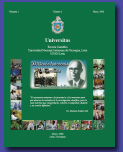Effect of physical and biochemical factors on the formation of infective structures Magnaporthe grisea pyriculiarosis causal agent of rice (Oryza sativa)
DOI:
https://doi.org/10.5377/universitas.v2i1.1641Keywords:
Colagenasa, Apresorio, Hidrofóbica, HidrofílicaAbstract
Downloads
References
Bonman, j.M. (1992). blast. P14-17. in: Compendium of Rice diseases. 2dn edition. St. Paul, MN: American Phytopathological Asociation Press.
Bourett, t.M., Picollelli, M.A. and Howard, R.j. (1993). Postembedment labeling of intracellular concanavalin A-binding sites in freeze-substituted fungal cells. exp. Mycol. 17:223-35.
https://doi.org/10.1006/emyc.1993.1021
Bourett,tM. and Howard, R.j. (1990). In vitro development of penetration structures in the rice blast fungus Magnaporthe grisea. Can. j. bot. 68:329-42
https://doi.org/10.1139/b90-044
Hamer, j.e, Howard, R.j., Chumley, F.G. and Valent, b. (1988). A mechanism for surface attachment in spores of a plant pathogenic fungus. Science 239:288-90
https://doi.org/10.1126/science.239.4837.288
Chaky, j., Anderson, K., Moss, M., and Vaillancourt, L. (2001). Surface hydrophobicity and surface rigidity induce spore germination in Colletotrichum graminicola. Phytopathology 91:558-564.
https://doi.org/10.1094/PHYTO.2001.91.6.558
Dean, R. A. (1997). Signal pathways and appressorium morphogenesis. Annu. Rev. Plant Pathol. 35:211-234.
https://doi.org/10.1146/annurev.phyto.35.1.211
FAO. (2002). Concern about rice production practices. Available fromhttp://www.fao.org/english/newsroom/news/2002/7538-en.html.
Gilbert, R. D., johnson, A. M., and Dean, R. A. (1996). Chemical signals responsible for appressorium formation in the rice blast fungus Magnaporthe grisea. Physiol. Mol. Plant Pathol. 48:335-346.
https://doi.org/10.1006/pmpp.1996.0027
IRRI. (2003). Welcome to rice doctor. 4 A.D. Available from http://www.knowledgebank.irri.org/riceDoctor_MX/Welcome_to_Rice_Doctor.htm
Kronstad, j.W. (1997). Virulence and cAMP in smuts, blasts and blights. trends Plant Sci. 2, 193-199.
https://doi.org/10.1016/S1360-1385(97)85226-0
Lee Y-H and Dean RA. (1994). Hydrophobicity of contact surface induces appressorium formation of Magnaporthe grisea. FeMS Microbiol. Lett. 115:71-76
https://doi.org/10.1111/j.1574-6968.1994.tb06616.x
Lee Y-H, Dean RA. (1993). cAMP regulates infection structure formation in the plant pathogenic fungus Magnaporthe grisea. Plant Cell 5:693-700
https://doi.org/10.2307/3869811
Podila, G. K., Rogers, L. M., and Kolattukudy, P. e. (1993). Chemical signals from avocado surface wax trigger germination and appressorium formation in Colletotrichum gloeosporioides. Plant Physiol. 103:267-272.
https://doi.org/10.1104/pp.103.1.267
Soares, D. M., S. M. teixeira, and M. F. Castro. (1990). Conjuntura da produção de arroz no brasil. In: Reunião Nacional de Pesquisa de Arroz. Goiânia, brasil.
Downloads
Published
How to Cite
Issue
Section
License
Copyright (c) 2008 UNIVERSITAS (LEÓN): SCIENTIFIC JOURNAL OF THE UNAN-LEÓN

This work is licensed under a Creative Commons Attribution-NonCommercial-ShareAlike 4.0 International License.
Copyright © Universitas (León), Revista Cientifíca de la UNAN-León. Academic Direction. Research Department. Publication and Scientific Event Unit.








